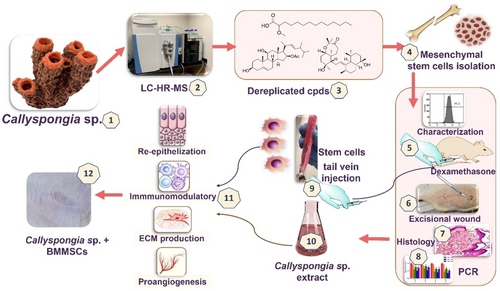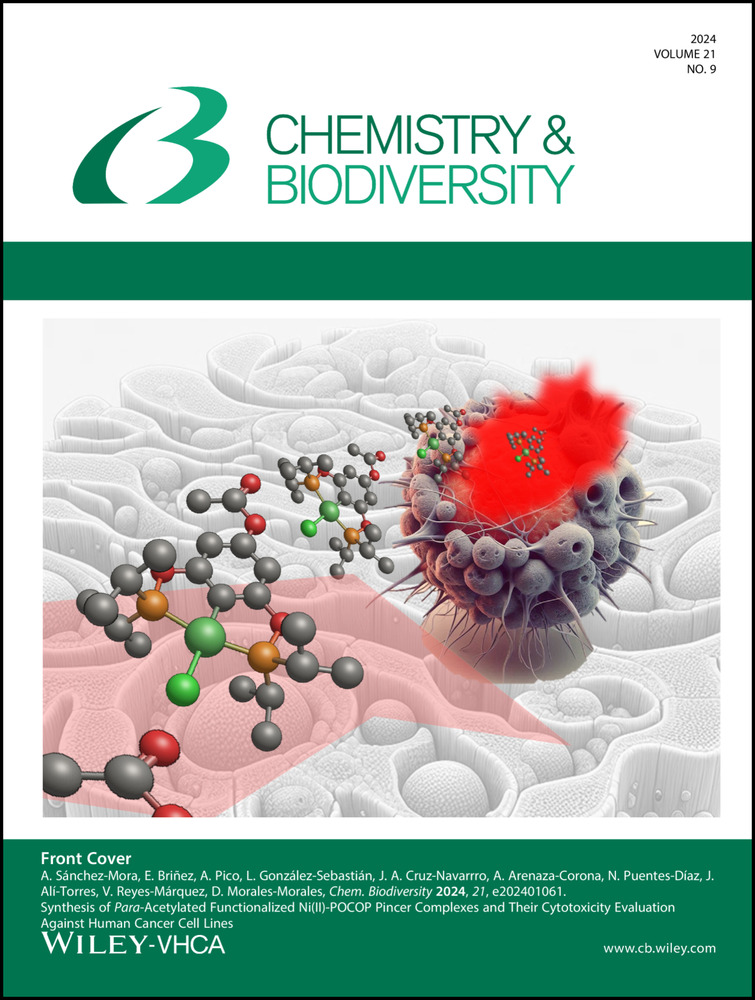Combination of Callyspongia sp. and Stem Cells for Wound Repair and Skin Regeneration: in Vivo and in Silico Evidences
Corresponding Author
Eman Maher Zahran
Department of Pharmacognosy, Faculty of Pharmacy, Deraya University, Minia, 61111 Egypt
These authors contributed equally to this work.
Search for more papers by this authorMiada F. Abdelwahab
Department of Pharmacognosy, Faculty of Pharmacy, Minia University, Minia, 61519 Egypt
These authors contributed equally to this work.
Search for more papers by this authorReham H. Mohyeldin
Department of Pharmacology, Faculty of Pharmacy, Deraya University, Minia, 61111 Egypt
Search for more papers by this authorOmar Y. Tammam
Department of Biochemistry, Faculty of Pharmacy, New Valley University, New Valley, Egypt
Search for more papers by this authorNehad M. Reda Abdel-Maqsoud
Department of Medical Science (Pathology), Deraya University, Minia, 61111 Egypt
Search for more papers by this authorFaisal H. Altemani
Department of Medical Laboratory Technology, Faculty of Applied Medical Sciences, University of Tabuk, Tabuk, 71491 Saudi Arabia
Search for more papers by this authorNaseh A. Algehainy
Department of Medical Laboratory Technology, Faculty of Applied Medical Sciences, University of Tabuk, Tabuk, 71491 Saudi Arabia
Search for more papers by this authorMohammed A. Alanazi
Department of Medical Laboratory Technology, Faculty of Applied Medical Sciences, University of Tabuk, Tabuk, 71491 Saudi Arabia
Search for more papers by this authorMohammed M. Jalal
Department of Medical Laboratory Technology, Faculty of Applied Medical Sciences, University of Tabuk, Tabuk, 71491 Saudi Arabia
Search for more papers by this authorMahmoud A. Elrehany
Department of Biochemistry, Faculty of Pharmacy, Deraya University, Minia, 61111 Egypt
Search for more papers by this authorGerhard Bringmann
Institute of Organic Chemistry, University of Würzburg, Am Hubland, 97074 Würzburg, Germany
Search for more papers by this authorCorresponding Author
Usama Ramadan Abdelmohsen
Department of Pharmacognosy, Faculty of Pharmacy, Deraya University, Minia, 61111 Egypt
Department of Pharmacognosy, Faculty of Pharmacy, Minia University, Minia, 61519 Egypt
Search for more papers by this authorCorresponding Author
Eman Maher Zahran
Department of Pharmacognosy, Faculty of Pharmacy, Deraya University, Minia, 61111 Egypt
These authors contributed equally to this work.
Search for more papers by this authorMiada F. Abdelwahab
Department of Pharmacognosy, Faculty of Pharmacy, Minia University, Minia, 61519 Egypt
These authors contributed equally to this work.
Search for more papers by this authorReham H. Mohyeldin
Department of Pharmacology, Faculty of Pharmacy, Deraya University, Minia, 61111 Egypt
Search for more papers by this authorOmar Y. Tammam
Department of Biochemistry, Faculty of Pharmacy, New Valley University, New Valley, Egypt
Search for more papers by this authorNehad M. Reda Abdel-Maqsoud
Department of Medical Science (Pathology), Deraya University, Minia, 61111 Egypt
Search for more papers by this authorFaisal H. Altemani
Department of Medical Laboratory Technology, Faculty of Applied Medical Sciences, University of Tabuk, Tabuk, 71491 Saudi Arabia
Search for more papers by this authorNaseh A. Algehainy
Department of Medical Laboratory Technology, Faculty of Applied Medical Sciences, University of Tabuk, Tabuk, 71491 Saudi Arabia
Search for more papers by this authorMohammed A. Alanazi
Department of Medical Laboratory Technology, Faculty of Applied Medical Sciences, University of Tabuk, Tabuk, 71491 Saudi Arabia
Search for more papers by this authorMohammed M. Jalal
Department of Medical Laboratory Technology, Faculty of Applied Medical Sciences, University of Tabuk, Tabuk, 71491 Saudi Arabia
Search for more papers by this authorMahmoud A. Elrehany
Department of Biochemistry, Faculty of Pharmacy, Deraya University, Minia, 61111 Egypt
Search for more papers by this authorGerhard Bringmann
Institute of Organic Chemistry, University of Würzburg, Am Hubland, 97074 Würzburg, Germany
Search for more papers by this authorCorresponding Author
Usama Ramadan Abdelmohsen
Department of Pharmacognosy, Faculty of Pharmacy, Deraya University, Minia, 61111 Egypt
Department of Pharmacognosy, Faculty of Pharmacy, Minia University, Minia, 61519 Egypt
Search for more papers by this authorAbstract
Delayed healing of chronic wounds results in amputation and mortality rates in serious cases. The present study examines the merged wound-restorative efficacy of injectable bone marrow-derived mesenchymal stem cells (BMMSCs) and topical Callyspongia sp. extract in immunocompromised rats. HR-LC–MS analysis of Callyspongia sp. extract tentatively identified twenty-nine compounds (1–29) and highlighted its richness in fatty acids and terpenoids, known for their wound regenerating efficacies. The wound closure was greatly prominent in the BMMSCs/Callyspongia sp. group in contrast to the control group (p<0.001). The RT-PCR gene expression emphasized these results by attenuating the oxidative, inflammatory, and immunity markers, further confirmed by histopathological findings. Additionally, in silico modeling was particularly targeting matrix metalloproteinase-9 (MMP9), a key player in wound healing processes. Computational analysis revealed that compounds 18 and 19 potentially modulate MMP9 activity. The combination of BMMSCs and topical Callyspongia sp. extract holds a promise for regenerative therapy constituting a drastic advance in the wound cure of immunocompromised patients, eventually further safety assessments and clinical trials are required.
Graphical Abstract
Conflict of Interests
The authors declare that they have no conflicts of interest.
Open Research
Data Availability Statement
All data have been included in the manuscript and supplementary materials.
Supporting Information
As a service to our authors and readers, this journal provides supporting information supplied by the authors. Such materials are peer reviewed and may be re-organized for online delivery, but are not copy-edited or typeset. Technical support issues arising from supporting information (other than missing files) should be addressed to the authors.
| Filename | Description |
|---|---|
| cbdv202400682-sup-0001-misc_information.pdf1.2 MB | Supporting Information |
Please note: The publisher is not responsible for the content or functionality of any supporting information supplied by the authors. Any queries (other than missing content) should be directed to the corresponding author for the article.
References
- 1A. H. Elmaidomy, et al., Molecules 2022, 27(17), 5617.
- 2E. M. Zahran, et al., RSC Adv. 2021, 11(57), 36042–36059.
- 3L. H. N. de Sousa, et al., Mar. Drugs 2021, 19(12), 663.
- 4C.-K. Kim, et al., Sponge J. Nat. Prod. 2016. 79(4), 1179–1183.
- 5Z. SABAPARA, P. PORIYA, Indo Pac. J. Ocean Life 2024, 8(1) 24–38.
- 6S. R. Ibrahim, et al., Bioorg. Med. Chem. 2010, 18(14), 4947–4956.
- 7Y. Elsayed, et al., Phytochem. Anal. 2018. 29(6), 543–548.
- 8C. A. Gray, et al., J. Org. Chem. 2006, 71(23), 8685–8690.
- 9U. R. Abdelmohsen, et al., Planta Med. 2015, 81(05), 382–387.
- 10A. Umeyama, C. Nagano, S. Arihara, J. Nat. Prod. 1997, 60(2), 131–133.
- 11B. Yang, et al., Nat. Prod. Res. 2013, 27, 433–437.
- 12S. R. Ibrahim et al., Arkivoc 2008, 2008 (12), 164–171..
10.3998/ark.5550190.0009.c18 Google Scholar
- 13A. Castaldi, et al., Mar. Drugs 2022, 20(11), 673.
- 14R. Huang, et al., Chem. Nat. Compd. 2011, 46, 1010–1011.
- 15N. M. Carballeira, M. Pagán, J. Nat. Prod. 2001, 64(5), 620–623.
- 16M. Kobayashi, et al., Tetrahedron Lett. 1997, 38(16), 2859–2862.
- 17S. S. El-Hawary, et al., Mar. Drugs 2019, 17(8), 465.
- 18H. A. El-Naggar, et al., Appl. Sci. 2022, 12(3), 1400.
- 19R. Esposito, et al., Mar. Drugs 2022, 20(4), 244.
- 20A. Fristiohady, et al., Asian J. Pharm. Clin. Res. 2019, 12(12), 97–100.
- 21G. Daletos, et al., J. Nat. Prod. 2015, 78(8), 1910–1925.
- 22M. S. Buchanan, et al., J. Nat. Prod. 2007, 70(12), 2040–2041.
- 23N. Murakami, et al., Tetrahedron Lett. 1997, 38(31), 5533–5536.
- 24H. A. Wallace, B. M. Basehore, P. M. Zito, Wound Healing Phases 2023, StatPearls Publishing, Treasure Island (FL), PMID: 29262065.
- 25J. Dissemond, M. Romanelli, Br. J. Dermatol. 2022, 187(2), 167–177.
- 26E. M. Zahran, et al., Food Funct. 2022, 13(13), 6859–6874.
- 27E. M. Zahran, et al., Antibiotics 2023, 12(1), 43.
- 28T. Al-Warhi, et al., Antioxidants 2022, 11(5), 881.
- 29W. M. Jackson, L. J. Nesti, R. S. Tuan, Stem Cells Transl. Med. 2011, 1(1), 44–50.
- 30C. Giesert, et al., Ann. N. Y. Acad. Sci. 2003, 996(1), 227–230.
- 31J.-H. Chen, et al., Bioorg. Med. Chem. Lett. 2012, 22(9), 3177–3180.
- 32D. T. Youssef, et al., Nat. Prod. Commun. 2010, 5(1), 27–31.
- 33E. M. Zahran, et al., Nat. Prod. Res. 2021, 35(22), 4757–4763.
- 34A. R. Giles, et al., Thromb. Haemost. 1987, 58(08), 1078–1084.
- 35A. Gupta, G. Jain, R. Raghubir, J. Pharmacol. Toxicol. Methods 1999, 41(4), 183–187.
- 36G. K. Keshri, et al., PloSOne 2016, 11(11), e0166705.
- 37M. A. Vidal, et al., Vet. Surg. 2007, 36(7), 613–622.
- 38H. O. Adly, A. El-Wahab, Abdel-Aziz, A. El-Shamy, R. Galhoom, M. Hashem, M. Ahmed, Al-Azhar Int. Med. J. 2021, 2(11), 37–42.
- 39W. Strober, Curr. Protoc. Immunol. 2015. 111(1), A3.B.1-A3.B.3.
- 40L. Wei, et al., J .Transl. Med. 2014, 12(1), 246.
- 41X. Wang, et al., Nucleic Acids Res. 2017, 45(W1), W356–W360.
10.1093/nar/gkx374 Google Scholar
- 42R. Huey, Garrett M. Morris, Scripps Res. Inst. Mol. Graphics Lab. 2012. 10550(92037), 1000.
- 43S. Yuan, H. C. S. Chan, Z. Hu, WIRES Comput. Mol. Sci. 2017, 7(2), e1298.
- 44J. C. Phillips, et al., J. Comput. Chem. 2005, 26(16), 1781–1802.
- 45J. V. Ribeiro, R. C. Bernardi, T. Rudack, K. Schulten, E. Tajkhorshid, Biophys. J. 2018, 114(3), 673a–674a.
10.1016/j.bpj.2017.11.3632 Google Scholar
- 46W. Humphrey, A. Dalke, K. Schulten, J. Mol. Graphics 1996, 14(1), 33–38.
- 47B. R. Miller III, et al., J. Chem. Theory Comput. 2012. 8(9), 3314–3321.
- 48W. A. Gallimore, M. Kelly, P. J. Scheuer, J. Nat. Prod. 2001, 64(6), 741–744.
- 49C.-M. Cui, et al., J. Nat. Prod. 2010. 73(11), 1780–1784.
- 50S.-S. Gao, et al., Bioorg. Med. Chem. Lett. 2011, 21(10), 2894–2897.
- 51S. Carmely, Y. Kashman, J. Org. Chem. 1983, 48(20), 3517–3525.
- 52S. Jain, et al., J. Nat. Prod. 2009, 72(7), 1291–1298.
- 53S. Jain, et al., Planta Med. 2007, 73(06), 591–596.
- 54Y. Kashman, T. Yosief, S. Carmeli, J. Nat. Prod. 2001, 64(2), 175–180.
- 55S. Jain, et al., J. Nat. Prod. 2007, 70(6), 928–931.
- 56S. Carmely, Y. Kashman, J. Org. Chem. 1986, 51(6), 784–788.
- 57B. Yang, et al., Helv. Chim. Acta 2009, 92(6), 1112–1117.
- 58B. Yang, et al., Rec. Nat. Prod. 2016, 10(1), 117.
- 59S. Kehraus, G. M. König, A. D. Wright, J. Nat. Prod. 2002, 65(7), 1056–1058.
- 60B. Yang, et al., Chem. Nat. Compd. 2012. 48, 350–351.
- 61L. Xiao-Jian, et al., Chin. J. Spectrosc. Lab. 2005. 22, 281–283.
- 62J. C. Braekman, et al., J. Nat. Prod. 2003, 66(6), 871–872.
- 63R. Hong, et al., J. Ocean Univ. China 2006, 5, 75–81.
10.1007/BF02919379 Google Scholar
- 64B. E. Rink, et al., Stem Cell Res. Ther. 2017, 8(1), 166.
- 65X. Liu, et al., Nucleic Acids Res. 2010, 38(2), W609–W614.
- 66V. W. Wong, et al., Ann. Surg. 2014, 260(6), 1138–1146.
- 67H. Cho, et al., Wound Repair Regener. 2016, 24(5), 829–840.
- 68M. J. Reiss, et al., Surgery 2010, 147(2), 295–302.
- 69E. Maher Zahran, et al., Food Funct. 2022, 13(21), 11083–11096.
- 70P. C. Calder, Proc. Nutr. Soc. 1996. 55(2), 737–774.
- 71E. M. Zahran, et al., S. Afr. J. Bot. 2020, 131, 311–319.
- 72K. Anderson, R. L. Hamm, J. Am. Coll. Clin. Wound Spec. 2012, 4(4), 84–91.
- 73G. Ren, et al., Stem Cells Transl. Med. 2011, 1(1), 51–58.
- 74L. Chiossone, et al., Stem Cells 2016, 34(7), 1909–1921.





